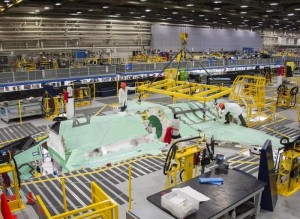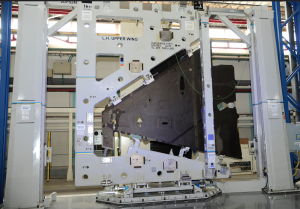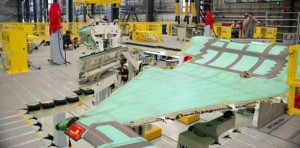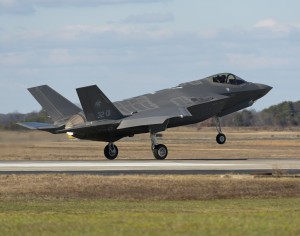2016-03-10 By Robbin Laird
When the first F-35 crossed the Atlantic from Cameri, Italy, to NAS Patuxent River, Maryland, the plane had been assembled in Italy and had only 15 flight hours illustrating the confidence of Lockheed Martin and the Italian Government (and Italian pilot) in the maturity of the aircraft.
The wings on the aircraft, designated AL-1, had actually been built in Fort Worth with other sections having come from Northrop Grumman Company or the U.K.
The Finmeccanica plant in Cameri has a final assembly and checkout facility (FACO) for the F-35 and is also building wings not just for the planes to be final assembled in Italy (namely for the Italian and Dutch Air Forces) but for the U.S. and other partners as well.
The work contracted to Finmeccanica-Alenia Aermacchi, a strategic supplier of F-35A full wing assemblies, is one of the largest manufacturing projects for the Italian F-35 program.
The Cameri FACO is owned by the Italian government and operated by Finmeccanica-Alenia Aermacchi in association with Lockheed Martin.
Under current industrial participation agreements, Alenia Aermacchi will produce a minimum of 835 full wings in addition to airframe parts that are consumed by their assembly operations including complex machined bulkheads and fiber placed composite parts. Alenia Aermacchi’s full rate of production will be 66 wings per year, expandable to 72 wings annually.
https://www.f35.com/global/participation/italy-industrial-participation

The first F-35 wing produced in Italy was integrated into the Fort Worth FACO in the spring of 2015.
The entry into the Electronic Mate and Assembly (EMAS) – where the forward fuselage, center fuselage, wing and aft fuselage are joined, in May 2015 was an important production milestone for Finmeccanica-Alenia Aermacchi’s F-35 program, exhibiting high performance on a vital part of the aircraft while demonstrating successful technology transfer, and the key involvement of the Italian aerospace industry.
The Cameri FACO’s F-35 production operations began in July 2013 and rolled out Italy’s first F-35A aircraft, AL-1, in March 2015; AL-1’s first flight was completed in September 2015.
Complete or full wings for the F-35 are only built in Cameri and Fort Worth, but Israel Aerospace Industries (IAI) builds outer wing boxes as well.
Outer wing boxes are shipped to the United States and are mated at the Fort Worth plant to the center wing sections produced by Lockheed Martin in Marietta, Georgia.
IAI has built an F-35 production line to build wing boxes and will do so for the U.S. Air Force and European customers.
It is anticipated that IAI will produce more than 800 F-35 outer wing boxes over the next 10-15 years for a potential value of $2.5 billion.
IAI received its initial contract from Lockheed Martin for F-35 wing sets in 2013 and subsequently invested in a state-of-the-art automated F-35 wing production line which is nearly identical to the line in Fort Worth, Texas.
It is located at the production center at IAI’s Lahav Division, which is experienced in manufacturing wings for F-16 and T-38 aircraft.
These IAI-produced left and right wing boxes are a complex part of the plane and support the overall supportable low observable JSF philosophy.
Supportable low observables imply significantly reduced maintenance hours per flight hour for the F-35 customers.

In addition, sensors are precisely installed on and in the wing during the final assembly manufacturing process to ensure performance of the avionic systems.
The level of precision required by a stealth-enabled aircraft is much greater than that required for fourth generation (F-16, F-18, F-15) aircraft.
To get a sense of the nature of the wing manufacturing process and the challenge of getting it right, I asked Don Kinard, an expert on F-35 manufacturing at Lockheed Martin, to explain the process.
“The key manufacturing technology to build the wings (and other JSF components) is all tied up with what we call outer mold line control.
Although at first look the wings appear to be simple structure, the technology required to meet the tolerances is quite complex.
We developed outer mold line control processes here in Fort Worth, and at our Partners (Northrop Grumman and BAE Systems), and at our suppliers for the Joint Strike Fighter program that involve, for example, controlling the thickness of the composite skins.
This is accomplished in two different ways.
We in Fort Worth control the wing skins by using a laser radar system and a patented process that Lockheed Martin Aeronautics at Fort Worth developed called cured ply compensation.
We cure the part, the wing skin for example, on the cure tool, and we then we measure the part thickness using a laser radar system.
Then by subtracting the tool surface measurements from the tool plus cured skin process we have the part thickness.
We send the part thickness data to a ply cutter which cuts and identifies all of the glass plies that we need to add to the cured wing skin to bring the wing thickness up to the nominal Engineering dimension, and then we project the location of the glass plies on the wing using a laser projection system and re-cure the wing in order to control the exact thickness.
The addition of glass plies compensates for the thickness variation in the composite and yields a controlled thickness skin.
We do that because we want all the skins to match up perfectly and if they are tightly controlled from a thickness point of view they should not create mismatches on assembly.
If we control the substructure, if we control the skins, then when we assemble the aircraft we don’t have mismatches, which increase drag and impact observable performance.
Prior aircraft depended on what we call a “fill and fair” approach where we would fill and fair mismatches across the joints using filler materials.
When aircraft are in flight, the joints are stressed and move around causing the filler materials to crack and resulting in maintenance actions on those jets to restore performance.
With the F-35, because of the outer mold line control on the airplane, we eliminate these fill and fair repairs and provide a more durable and maintainable product for the customers.
We are already seeing the maintenance hours per flight associated with F-35 maintenance to be about a tenth of what we’ve seen in the past.
Now we’re still young and, we have the opportunity to improve even more over this initial success, but that’s where we are now.”
Question: Because of this manufactured stealth, this inherent capability is built into the aircraft for the life cycle of the aircraft as well?
Kinard: That is correct.
One of our passions over the past 15 years has been to develop the manufacturing process to so tightly control the outer mold line of the airplane that we don’t have to fill and fair.

We reduce LO maintenance hours on the aircraft over the life of the aircraft because of that.
To do so requires complex technology.
I’ve mentioned the first approach which is the laser radar system for the wing.
We call it a “cured laminate compensation” or CLC process where we compensate for thickness variation by adding glass plies; this is a process patented by Lockheed Martin Aeronautics and developed by our Manufacturing Technology organization.
Now the other way that it’s done, which was originally brought to the F-35 team by our partner BAE Systems, is the approach we use on the forward fuselage and other sections of the aircraft like the aft fuselages (BAE), center fuselages (NGC), and empennage (BAE).
Just to give you a little of breadth here, we put sacrificial material on the inner mold line or the inside of the composite skin and machine it away in very high-precision machine equipment that once again controls the thickness of the part to very tight dimensions.
This process is used here in Fort Worth, in Northrop Grumman, and every place where the aircraft are made.
The two processes yield the same result, one is the cured laminate compensation approach; another one is machining sacrificial plies.
We also put sacrificial material on the substructure, for example, around the outside of the forward fuselage after we assemble it and then take that whole forward fuselage into a machine and machine it to control the outer mold line.
Again, remember that the ultimate objective for F-35 is a supportable platform to reduce maintenance to lower costs and improve overall aircraft availability for the customers.
We developed that technology as part of the F-35 team with Northrop Grumman and BAE.
Now all of us take that technology and transfer to other producers of the parts and components like Finmeccania and IAI for Lockheed Martin, TAI in Turkey for the NGC center fuselages, and Terma in Denmark, and Quick Step in Australia for the BAE Empennage.
We send our people over to Italy and Israel.
We review their equipment suppliers, and procedures, because fundamentally, at the end of the day the parts made in Italy and the parts made in, in Israel have to be identical to the parts we make in the United States, which is true for all of the international participants in the F-35.
Philosophically Lockheed Martin is responsible for delivering a compliant aircraft, and then we deliver the aircraft to our US government customer – the DCMA – who then turns the airplanes over to the purchasing countries.
Lockheed Martin is guaranteeing that all of the aircraft processes are done the same.
In fact, that technology transfer, the manufacturing technology transfers for the F-35 have been one of the incentives for other countries to participate because it’s not just the outer mold line philosophy, it’s the digital thread philosophies, such as optical projection of work instructions onto the aircraft surfaces, and the use of automation such as automated drilling and robotic spraying.
We share our manufacturing technologies as we develop them with our partners and our co-producers and suppliers so that we can lower the cost of the aircraft to everybody.
Finmeccania has already delivered several full wings out of Italy, and IAI has delivered several wing sets out of Israel.
The fact that we can not only build them ourselves but transfer technology to partners and suppliers around the globe to build identical products is another great indicator of the maturity of the program
Question: The precision of the drilling in the wing must be very high given the sensors which get then inserted and integrated into the wing.
Can you describe that challenge?
Kinard: Many sensors are attached to the wing and integrated into the wing. For example, the leading edges have a lot of sensors and obviously the trailing edges.
The F-35 has 360-degree sensors, basically around, but those are components that we add to the wing. The wing is built to then put those sensors on the wing and precision is crucial.
All the sensors have to be aligned in order for all of the avionics systems to work. And all of that is controlled and calibrated as we build the aircraft.
Question: Working with other nation’s industries must force you to clarify processes as you transfer them, but mutual learning is certainly possible.
Can you describe the approach?
Kinard: As we worked with the international participants we have learned things from everyone, these lessons learned are shared formally between sites.
The technology transfer is really a two-way street.
One of the beauties of the F-35 is the global interaction and that we have enough aircraft on our forecast to continue to develop manufacturing technologies way out to the future.
The F-35 has got a long runway, and so we continue to be very aggressive in technology development going forward.
And the division of labor allows for flexibility between international sites in production as well.

At some point IAI will build most of the A model wing boxes and we’re going to build the B and the C model wings here in Fort Worth.
Question: There were only four journalists at Pax River when the Italian aircraft assembled in Italy crossed the Atlantic. It was piloted by an Italian pilot with only 50 hours on the aircraft and the plane itself had only 15 flight hours on it.
What does that say about the maturity of production for the aircraft?
Kinard: How mature does it have to be to put a pilot in there with only a few hours of flight time, when almost anything could go wrong over the ocean?
I think that really shows how mature this plane is and how confident the pilots are. Because obviously the pilot wouldn’t have taken the flight unless he felt very comfortable with the airplane.
For earlier discussions with Don Kinard, including a 2010 interview on wing production, see the following:
https://www.sldinfo.com/shaping-f-35-production-maturity-a-dialogue-with-dr-don-kinard/
https://www.sldinfo.com/visiting-the-f-35-final-assembly-line-fort-worth/
https://www.sldinfo.com/an-update-on-f-35-manufacturing-the-case-of-wing-assembly/

